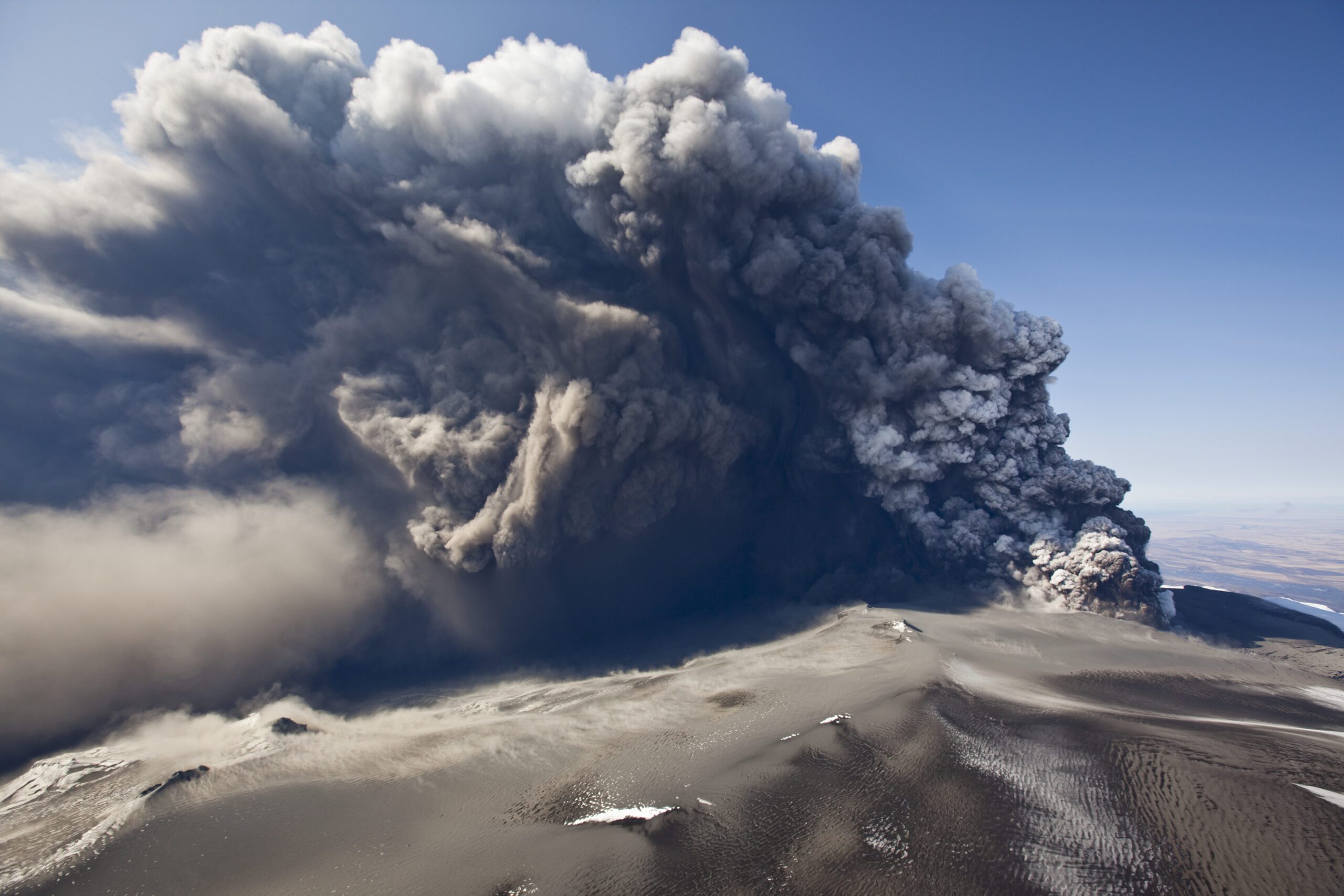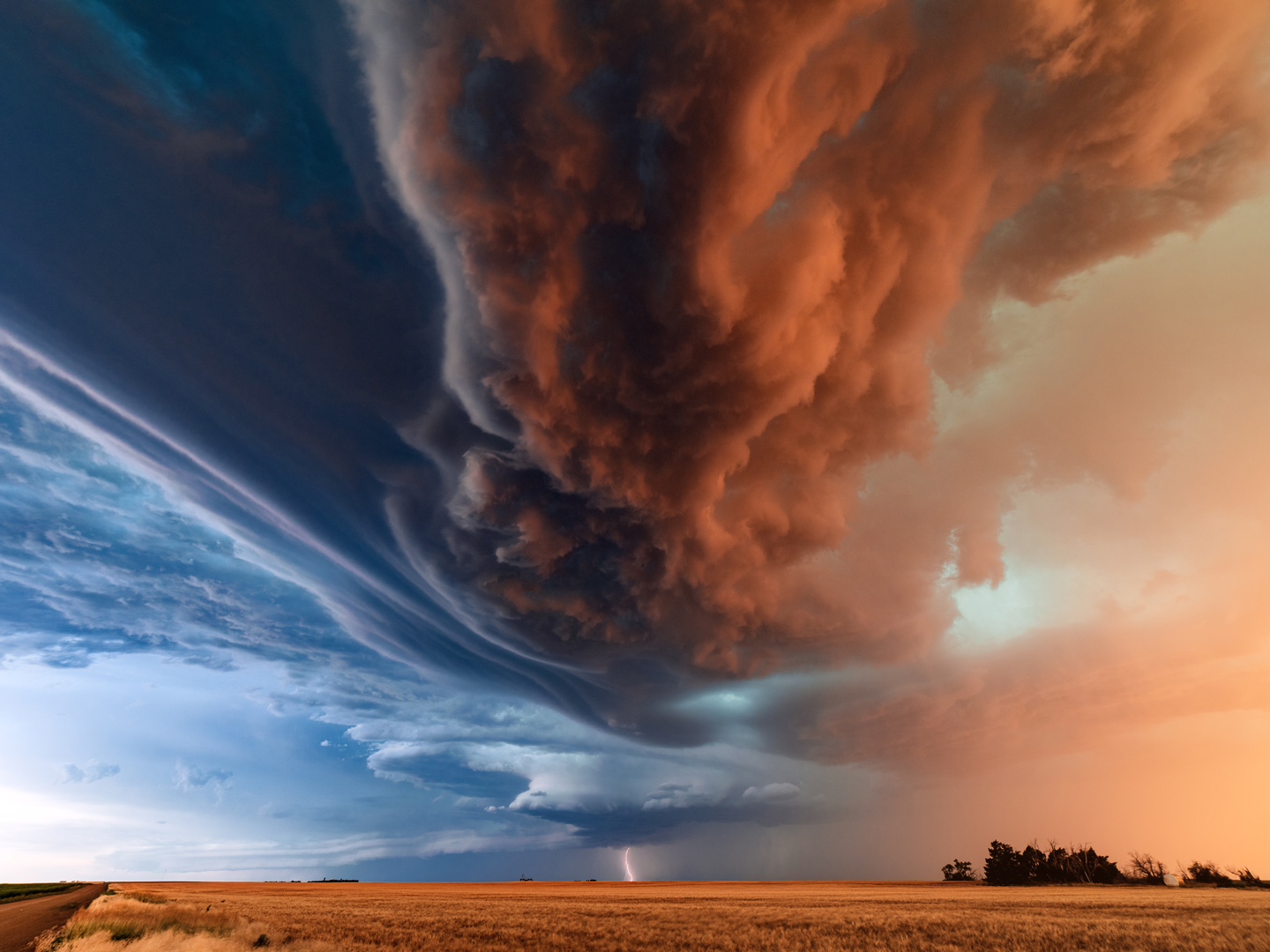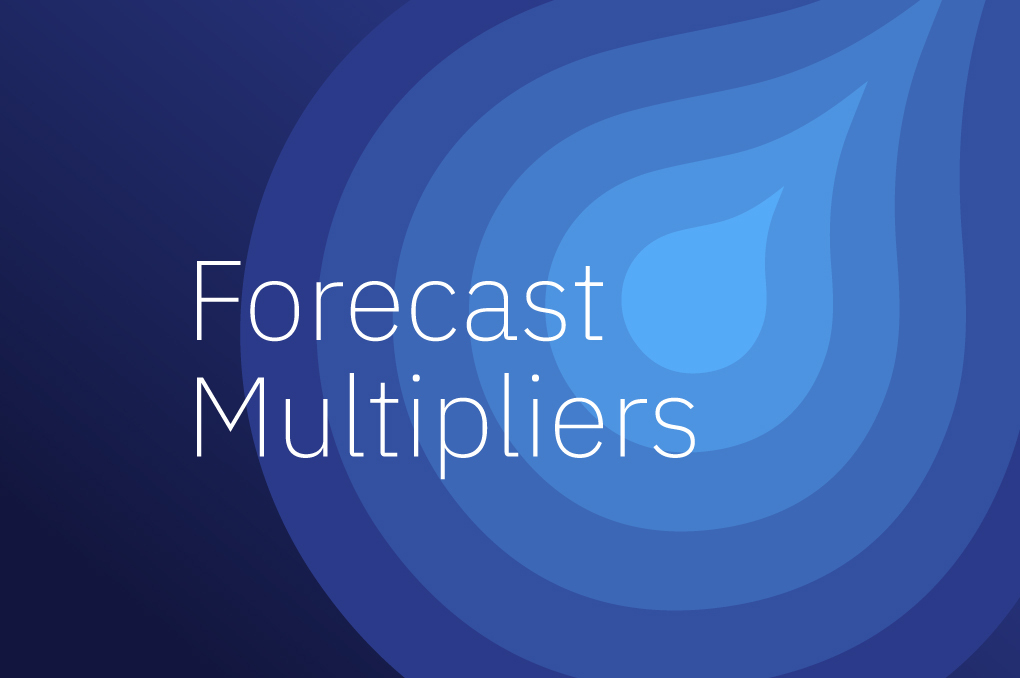Weather intelligence for the future: Crafting a strategic enterprise approach to changing environmental conditions
Continue readingEditor’s note: All data sourced from Weather and Health Impact Study, Sago for The Weather Company, March 2024, unless otherwise noted.
As the mercury dips and the days grow shorter, the connection between weather and health is unmistakable — in fact, 89% of consumers believe weather impacts their health. This link often drives decisions related to winter health and wellness, as people frequently use weather as a signal to plan their day, make informed decisions about dosage and frequency for certain medications, and prevent symptom flare-ups by understanding optimal times for activities.
So, how might this winter’s forecast influence consumers and health and wellness marketing campaigns? Let’s start with a few highlights from The Weather Channel’s winter outlook 2024-25:
- A mild-to-warm winter overall: Most of the U.S., except the Northwest, is forecast to bask in above-average temperatures, but prepare for potential cold bursts that could keep people inside and send health conditions into a flurry.
- Wetter than average conditions: From the Northwest to The Northern Plains, expected above-average precipitation could cause people to seek comfort indoors.
- Early spring: Southern regions might get an early taste of spring, which could signal an early start to allergy season.
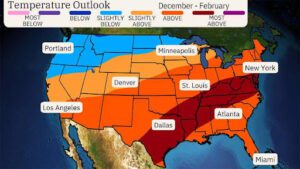
2024-25 winter outlook
The intersection of winter weather and wellness
You may not realize it, but winter weather can actually improve health and wellbeing. From joint pain relief, sharpened focus, improved sleep, or even weight-loss,1 cold weather has its benefits. It also has its drawbacks, heightening health conditions like cold and flu, Seasonal Affective Disorder (SAD), and asthma. With 76% of consumers using weather to manage their health — a 33% increase since 2020 — understanding how weather patterns impact daily habits is vital for crafting effective wellness in winter campaigns. So, bundle up and explore how the winter chill can be to your advantage this season.

Embrace the elements this season: Leverage the power of weather and digital advertising to ignite brand relevance and growth. Three ways health and wellness brands can put a weather strategy into action:
- Engage with qualified audiences across The Weather Channel app and weather.com premium consumer health experiences and content as they look to inform daily plans and health decisions from weather information.
- Activate health ads with Weather Targeting that leverages an intelligent mix of weather and anonymized health data to anticipate consumer behavior and drive action featuring over 100 health signals. With over 50% of Gen Z saying the most challenging thing about winter is lack of motivation, sleep, or energy (vs. 31% across demos),2 we’re launching three new signals to meet consumer needs during winter season: stress, anxiety, and sleep.
- Transform data into business intelligence with Weather Engine.TM Powered by AI and machine learning, Weather Engine is a decision-making platform and API integration that builds insights for businesses to optimize operations across the enterprise.
Make this winter your strongest season yet: Trust The Weather Company’s advertising solutions for insights and tools to elevate your brand and create better decisions for consumers.
Let’s talk
What’s your weather strategy? To learn more about harnessing the power of weather to increase engagement and drive growth, contact our advertising experts today.
Contact us1 “Why Winter Might be Good For You” weather.com, Nov. 2024
2 The Weather Company Winter 2022-23 Behavior Survey, Sept. 2022
3 ”What’s the link between cold weather and the common cold?” Medical News Today, Sept. 2022
4 Disqo 9/18 – 11/30/23
5 Brazienė, Agnė et al. “Relationship between Depressive Symptoms and Weather Conditions.” International journal of environmental research and public health vol. 19,9 5069. 21 Apr. 2022, doi:10.3390/ijerph19095069
6 “Seasonal affective disorder, winter blues and self-care tips to get ahead of symptoms”UC Davis Health Blog, Nov. 2023
7 PulsePoint, 2022
8 “Weather can trigger asthma” Asthma and Allergy Foundation of America, April 2024
9 IQVIA, 2017
Look no further than The Weather Channel’s winter 2024 outlook to discover how the season is shaping up across the country. And as those chilly temperatures arrive, so does something else: spring break weather wanderlust. For marketers, this presents a golden opportunity to showcase exactly what travelers need to turn their daydreams into reality, from short-term packing decisions to long-term destination planning.
Strike while the iron is hot, but the temperatures are not
Nearly half of consumers admit that winter weather fuels their desire to escape to warmer destinations.1 To help travel-related brands deliver real-time, personalized relevance, they can tap into weather’s proven influence on mindsets and behaviors. Bringing weather data together with impactful first and third-party datasets can enable better decisions for consumers, and a competitive edge for brands and businesses. So, when decision-making kicks in for the ultimate spring break travel adventure, we’ll help you reach consumers at the optimal time and place.
of millennials say “winter blues” is the most challenging thing about the season1
Weather impacts travelers emotionally and physically, making it a key factor for brands to consider. Because weather intelligence allows brands to reach people during specific conditions and when they are in the right mindset, marketers can use this valuable tool to influence consumer behaviors.
From choosing a beach or ski resort to deciding what to pack, the forecast plays a role throughout the entire travel journey. And let’s not forget the impact of weather on air travel — because nothing says “vacation vibes” like a surprise snowstorm canceling your flight. In fact, a recent Expedia Group report named “weather” as the top influencer of trip destinations for travelers considering multiple destinations. It’s no wonder 67% of people use The Weather Channel, the world’s most accurate forecaster, to research or plan their trips.2
Take it from Mother Nature: Real-time weather drives winning campaigns
Weather doesn’t only come into play when planning the perfect vacation during spring break, it shapes the trip itself. Nearly two-thirds of people say weather and travel conditions impact their enjoyment of a trip while more than half of travelers are open to trying new product brands during their travels.2 This means all brands can benefit from using weather data to reach those travel-savvy consumers at the right moments.
Capturing that moment when consumers are in the right mindset, at the right time, is precisely the use case for Weather Targeting’s predictive and performant capabilities driving relevancy, action, and effective messaging. For instance, when a hotel brand wanted to increase awareness and consideration of its beachfront resorts, they leveraged Weather Targeting to efficiently reach consumers when cold, wintry, and rainy weather was present in their local area. Compared to third-party cookie targeting, using Weather Targeting to engage travelers and loyalty members helped their campaign break through the clouds:
lift in brand awareness3
lift in purchase intent3
higher brand favorability3
Remember, the daily forecast isn’t just a local phenomenon; it’s universal. As the ultimate contextual signal, it influences every aspect and decision of people’s lives – consciously or not. It affects how we feel, what we do, where we go, and what we buy. In this late-winter limbo, kickstart spring travel campaigns by integrating weather targeting solutions and data into marketing plans to drive relevance, awareness, and ultimately, conversion.
Let’s talk
What’s your weather strategy? To learn more about harnessing the power of weather to increase engagement and drive growth, contact our advertising experts today.
Contact us1 The Weather Company Winter 2022-23 Behavior Survey, Sept. 2022
2 The Weather Company Travel 2022 Behavior Survey, June 2022
3 Lucid
- The ability to forecast volcanic ash accurately is vital, as ash can lead to severe engine damage and operational disruptions in aviation.
- The Weather Company offers real-time, global volcanic ash advisory forecasts to help airlines proactively plan routes to avoid hazardous airspace.
- Advanced tools like RGB satellite imagery and webcams provide precise tracking of volcanic ash for safer flight operations.
- Impact reports from The Weather Company enhance situational awareness for airports near active volcanoes and help minimize the risk of disruptions.
- The Weather Company’s unique tools, such as the Enroute Hazards package and enhanced SIGMETs, provide airlines with advanced insights to avoid hazardous airspace and maintain safe operations.
Volcanic ash is a danger that can turn a routine flight into a risky endeavor, damaging engines, blinding pilots, grounding entire fleets, and putting passenger safety at risk. For airlines, the stakes are high, making the need for accurate forecasting inclusive of volcanic ash extremely critical. With industry-leading tools that go beyond standard advisories, such as the Enroute Hazards package and enhanced volcanic ash SIGMETs, The Weather Company’s forecast solutions provide aviation leaders with real-time insights to help outmaneuver ash clouds, keep flights on track, and greatly improve safety for passengers and crew.
The operational risks of volcanic ash


Volcanic ash can cause severe damage to aircraft engines, leading to potentially dangerous situations mid-flight. The ash particles are highly abrasive and can melt inside the engine’s combustion chambers, creating blockages that can result in engine failure. In addition to engine damage, volcanic ash can interfere with navigation systems, obstruct windshields, and drastically reduce visibility, all of which elevate the risk of flying through affected airspace.
These risks often force airlines to reroute flights, delay departures, or even cancel operations, leading to costly disruptions and logistical headaches. As ash clouds move through the atmosphere, operational leaders need precise and timely information to make quick decisions and avoid unnecessary impacts on both passengers and airline schedules.
Comprehensive forecasting for aviation safety
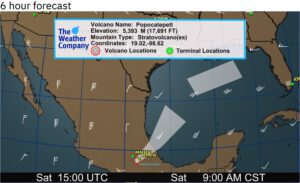

Volcanic Ash forecast Flight Plan Guidance (FPGs) display
To address these challenges, The Weather Company offers industry-leading tools, such as the Enroute Hazards package, designed to enhance volcanic ash and aviation safety for aviation customers of all sizes. Beyond the basic Volcanic Ash Advisory Center (VAAC) bulletins, our services include enhanced volcanic ash SIGMET (Significant Meteorological Information) notifications, which are triggered when ash reaches key thresholds: 6,000 feet above the summit of a volcano or 10,000 feet above ground, extending over 50 nautical miles. SIGMETs are also issued for added safety if ash is detected near customer destinations, even if it doesn’t meet these thresholds.
Real-time monitoring and advanced tools
Monitoring volcanic ash in real-time is complex, but The Weather Company offers robust tools for precise tracking. RGB satellite imagery, created using GOES-East and GOES-West satellites, offers accurate identification and monitoring of volcanic ash in the atmosphere, even in complicated weather conditions. By employing techniques like channel differencing with the ash-sensitive 8.4-micron channel, this imagery allows forecasters to confidently differentiate ash from other elements like steam or water vapor.
To further refine these forecasts, The Weather Company leverages third-party webcams to visually monitor volcanic activity in real time. These webcams provide continuous views of volcanoes like Popocatépetl in Mexico, which allow forecasters to distinguish between ash emissions and less threatening emissions like steam or gas. When combined with satellite data, this real-time monitoring enables assessments of volcanic activity, leading to better decision-making by airline operations teams.
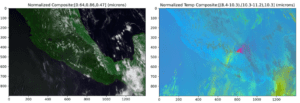

RGB imagery enhances satellite data to highlight atmospheric particulates. Using channels sensitive to volcanic ash (8.4 µm) helps forecasters identify affected areas.
Ash forecast modeling
For larger eruptions, The Weather Company uses sophisticated ash forecast modeling to predict how ash will disperse through the atmosphere. These forecasts are generated using GFS-based weather models that take into account jet streams and other atmospheric factors to predict how ash clouds will move and interact with flight paths. This type of modeling is crucial for larger eruptions where ash can linger in the atmosphere for days or even weeks, posing extended risks to aviation.
For minor ash emissions, existing patterns of ash movement support decision-making. For larger eruptions, forecasts of ash dispersion provide airlines with critical information on ash location and projected movement, helping them to plan effectively for immediate and long-term impacts.
Potential volcanic ash impact reports
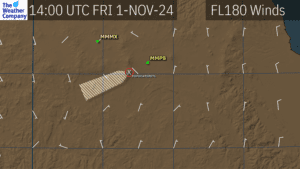

Potential Volcanic Ash Impact Report tracks daily volcanic ash movement, aiding aviation planning near active volcanoes.
Daily aviation volcanic ash reports are another critical component of our service, particularly for airports located near active volcanoes. Airports like those near Popocatépetl, Fuego, and Sangay receive continuous updates on the potential movement of ash toward key airspace and terminals. While these reports don’t predict explosive events, they do provide detailed insights into how current volcanic emissions might affect nearby operations.
These reports are invaluable for situational awareness, especially for airports that operate under the constant risk of volcanic activity. By offering advanced notice of potential ash impacts, airports and airlines can make proactive adjustments, reducing the risk of unexpected disruptions.
Human-over-the-loop reports for comprehensive insights
Navigate volcanic ash hazards with confidence using The Weather Company’s detailed Human-Over-the-Loop (HOTL) Reports. These reports compile relevant volcanic ash data into easy-to-read PDFs, featuring essential information such as SIGMETs, wind barbs, and satellite imagery. With this consolidated data, airlines gain a comprehensive understanding of the current situation, allowing for more informed decisions regarding flight safety and route planning.
The HOTL reports put all relevant information in one place, offering a comprehensive picture of volcanic activity in real time. Operational leaders can take immediate, decisive action to adjust flight operations, minimizing risks and keeping passengers and crew safe.
Staying ahead with proactive volcanic ash forecasting
Volcanic ash presents significant risks to aviation, but these challenges can be effectively managed through proactive planning and real-time insights. The Weather Company’s suite of solutions helps airlines stay ahead of disruptions, empowering decision makers to help maintain safe and efficient operations, even in volatile conditions. And, because forecasting services from The Weather Company seamlessly integrate into current operational workflows, airlines can start taking advantage of this critical technology with minimal effort.
Don’t let volcanic ash cloud your operations. Elevate your airline’s safety and efficiency with The Weather Company’s industry-leading Weather Forecast Services.
Let’s talk
To learn more about our advanced aviation weather solutions, contact our aviation experts today.
Contact usLet’s face it: Mother Nature is a consistently dynamic business partner. Retailers who underestimate her impact might be overlooking one of the most influential factors in enterprise operations. Weather isn’t just about whether customers buy an umbrella or stock up on sunscreen; it’s a force that shapes consumer behavior and operational efficiencies in ways you might not expect.
Don’t just take our word for it. According to our recent research study,1 100% of retail executives agree that weather intelligence offers a competitive edge.
Weather intelligence from The Weather Company enables retailers to create strategies that not only drive sales growth but also strengthen customer relationships. It’s about optimizing your supply chain, mitigating risks, and keeping your team safe, all while meeting consumer needs more effectively.
believe that weather intelligence is extremely valuable for their business.
say using weather insights effectively can help them be better at their job.
report that weather significantly affects their operating costs, from supply chain disruptions to inventory management and product innovation.
Key areas where weather intelligence drives business success
The impact of weather extends far beyond consumer behavior—it touches every part of the retail enterprise.
Supply chain optimization: Supply chain management is often a retailer’s toughest puzzle piece, and weather adds an extra layer of complexity. With the right data in your toolkit, you can move from reacting to weather to proactively planning for it. Weather intelligence helps businesses optimize their supply chains in crucial ways. For example, it allows you to prepare for and mitigate severe weather disruptions, minimizing delays and reducing costs. It can also influence and enable you to anticipate demand surges during favorable weather conditions. For instance, you can ensure party supplies and refreshments are ready to ship out for the first pool parties of the season. By leveraging weather data, retailers are better able to maintain steady product availability across all conditions, maximizing customer satisfaction and sales opportunities while minimizing losses from weather-related supply chain issues.
Targeted marketing and promotions: Weather data isn’t just about forecasting sunny days and stormy ones; it’s about forecasting sales, too. Retailers can craft personalized marketing strategies that align with weather conditions, boosting engagement and conversions. Imagine offering free shipping on winter apparel as a cold front approaches, or when the sun cranks up the heat, crisp and refreshing beverages take center stage on your dynamic menu board. Retailers can also use weather intelligence to tailor promotions based on how customers prefer to shop – whether it’s in-store, online, or via buy online, pick up in-store – aligning offers to anticipate customer mindsets and needs. With weather data and intelligence, you’re not just harnessing the forecast – you’re forecasting customer delight.
Retail worker safety and operational continuity: Your workforce is the backbone of your operation. They’re the unsung heroes who keep the shelves stocked, the customers smiling, and the cash registers ringing. But when Mother Nature decides to throw a curveball, their safety becomes your number one concern. With data from the world’s most accurate forecaster accurate weather forecasts, retailers can implement safety protocols to help protect on-site personnel and maintain business continuity. Proactive measures such as adjusting store hours or staffing levels based on incoming weather can help employees and customers remain safe while keeping operations running smoothly.
Retail industry trends driven by weather intelligence
Changing weather patterns increasingly influence retail trends. Using historical weather data and trend analysis, retailers can anticipate these changes and adjust their plans accordingly. For example, a trend of warmer-than-usual winters might lead a retailer to rethink product inventory levels or start end-of-season sales earlier to clear out excess stock. Notably, 82% of retail executives say that the weather’s impact on their business is just as strong, if not stronger, than five years ago, stressing the need for long-term weather strategies.
Complexity to clarity: choosing the right weather intelligence partner
What retailers really want is weather data that speaks their language – no PhD required. They’re looking for tools that can slip right into their existing workflows, providing clear, actionable insights without the headache of decoding complex data. The Weather Company solutions like Weather APIs and the Weather Engine seamlessly integrate into existing systems and processes making working with this complex and invaluable business asset a breeze.
Case study: Weather intelligence in action
A leading pharmaceutical retailer partnered with The Weather Company to analyze the impact of weather on its sales using the custom modeling approach of the Weather Engine. The results revealed a strong correlation between weather conditions and sales in specific categories, such as cosmetics, cold remedies, and allergy medications. The estimated financial impact2 includes:
- Allergies: $90M – Weather affected 15% of allergy remedy sales, translating to $90 million annually out of $0.6 billion in total sales.
- Cold remedies: $112M – Cold weather impacted 8% of cold remedy sales, which accounts for $112 million annually from $1.4 billion in sales.
- Cosmetics: $55M – Weather had a 5% effect on cosmetics sales, contributing $55 million each year from $1.1 billion in total sales.
Why weather intelligence is essential for retail growth
All retailers need to recognize this simple truth: Understanding the impact of weather on retail operations — from sales to supply chain, promotions, and customer behavior — can transform challenges into powerful growth opportunities. Predicting these shifts may seem complex, but it becomes straightforward with the correct partner. As the world’s most accurate forecaster,3 The Weather Company provides hyperlocal, AI-powered insights that help you not only react to, but anticipate, market conditions. So, while your competitors are caught with their umbrellas down, you’ll be making Mother Nature your business ally.
See how executives across industries are leveraging weather intelligence. Get your free copy of the complete Weather Means Business report.
Let’s talk
What’s your weather strategy? To learn more about harnessing the power of weather to increase engagement and drive growth, contact our advertising experts today.
Contact us1 All data sourced from the Weather Means Business report, June 2024, Magid for The Weather Company.
2 Analysis by The Weather Company, from proprietary weather data and retailer’s first party data, 2023
3 ForecastWatch, Global and Regional Weather Forecast Accuracy Overview, 2017-2022, commissioned by The Weather Company
We all know that feeling — the anticipation of winter and the holiday season. Whether it sparks child-like excitement or a hectic whirlwind of activities, one thing is for sure: Emotions run high the last few months of the year. But is it just the calendar stirring those feelings, or could weather be playing a role in influencing holiday consumer behavior?
Weather: the unexpected force behind consumer emotion
Weather influences our everyday decisions in more ways than we realize. In fact, 84% of consumers across all generations admit that weather affects them emotionally.1 It’s why the shift in seasons is often a better gauge of consumer mindset than the date on the calendar. As the seasons change, people feel more optimistic, social, and ready for something new — making it the perfect moment for marketers to connect. According to The Weather Channel appTM users:
of Gen Z users are excited about the arrival of winter weather because of creating and enjoying cozy moments2
of millennial users are excited about the arrival of winter weather because of decorating their home2
of parents are excited about the arrival of winter weather because of holiday rituals and traditions2
But with climate patterns shifting globally, when does the “season” really start?
‘Tis it really the season?
Gone are the days when marketers could rely on a universal ‘start of winter’ to kickoff holiday campaigns. Today’s fluctuating seasons demand a more nuanced approach. For those aiming for timely, relevant campaigns, forward-thinking brands are embracing dynamic Weather Targeting, a powerful tool that allows brands to sync their messaging with the specific climatic cues that catalyze holiday shopping moods, regardless of the calendar date.
A beloved coffee chain leveraged The Weather Company’s expertise to tap into the holiday spirit and winter weather cravings. By combining Weather Targeting and high-impact dynamic creative on the homescreen, they aligned their limited-time offer messaging with real-time local weather conditions on The Weather Channel app. This strategy capitalized on the fact that 66% of people say winter weather impacts their beverage choices,2 and nearly half are excited about seasonal drinks.2 The result? An impressive 94,400 incremental store visits and a 12.2% lift in foot traffic, proving that understanding weather’s influence on consumer behavior can brew up significant success.3
The purchasing power of seasonal shifts
Winter weather doesn’t just mark a change in temperature; it signals a shift in seasonal buying trends, as evidenced by The Weather Channel app survey data:
of all users say they plan their holiday shopping and travel based on the weather4
of millennial users say they add seasonal foods and drinks to their menus once winter sets in4
of Gen Z users say winter weather prompts them to plan their weekend further in advance4
Let it snow, let them shop
Seasonal spending habits may seem tied to the holiday calendar, but it’s the weather that really dictates how consumers feel — and when they’re ready to spend.
Marketers can tap into this powerful insight by using proven, accurate weather data5 to target consumers at the right moment, with the right message. Weather Targeting is a privacy-friendly approach to contextual marketing that can predict consumer needs, helping brands future-proof their strategies with scalability across the advertising ecosystem.
Holiday marketing strategies will always be about timing, and with Weather Targeting, you’ll be ready when that seasonal excitement strikes. As the temperature falls, let the deals drop. That’s when the real holiday magic happens.
Let’s talk
What’s your weather strategy? To learn more about harnessing the power of weather to increase engagement and drive growth, contact our advertising experts today.
Contact us1 The Weather Company Spring 2022 Behavior Survey, December 2021
2 The Weather Company Winter 2022-23 Behavior Survey, September 2022
3 InMarket Q4 2023
4 The Weather Company Holiday Loyalty survey, June 2021
5 ForecastWatch, Global and Regional Weather Forecast Accuracy Overview, 2017-2022, commissioned by The Weather Company
Editor’s note: All data sourced from The Weather Company Entertainment Behavior Survey, January 2024
The entertainment industry is buzzing with anticipation this time of year, as cinema blockbusters and binge-worthy series hit the big screens and streaming platforms. But while studios and networks are busy promoting their latest and greatest, there’s an influential director getting rave reviews from marketers: Mother Nature.
Weather plays a starring role in our content consumption, from sunny days that lure us to the theater to stormy nights streaming a nostalgic film at home. This show-stopping link between weather and how we engage with media presents a unique opportunity for marketers seeking the spotlight.
The Weather Company helps brands tap into weather-driven strategies, so your campaigns are as irresistible as the aroma of fresh popcorn.
So grab your snacks, take your seat, and enjoy the show…


How to leverage weather data during “peak binge” season
Just as a director uses many techniques to create a cinematic masterpiece, savvy marketers can harness the power of accurate weather data1 to craft a seat-filling campaign full of offers consumers can’t refuse. Script your brand’s success story with Weather Targeting, which allows you to:
- Increase awareness through highly relevant, dynamic messaging
- Deepen the connection with content viewers by promoting brand products or services using Weather Targeting for OTT/CTV platforms
- Engage entertainment enthusiasts with contextual targeting solutions
- Foster brand loyalty in daily weather-influenced decision moments
Ready for your brand’s big break? With The Weather Company’s tailored solutions, your marketing may go from box-office snub to award-season darling.
Let’s talk
What’s your weather strategy? To learn more about harnessing the power of weather to increase engagement and drive growth, contact our advertising experts today.
Contact us1 ForecastWatch, Global and Regional Weather Forecast Accuracy Overview, 2017-2022, commissioned by The Weather Company
When it comes to Halloween — the preparation and the main event — there’s one thing consumers experience collectively, and universally rely upon throughout their journey: the weather.
Pre-event: Connect with consumers using weather information to plan and make event decisions.
During the holiday: Build strong customer relationships through the transformative and enduring power of weather.
Don’t get caught in the cobwebs this year — check out our “Fright Forecast” to learn how consumers use weather information to stay informed, make predictions, and prepare to celebrate under the moon.
Download infographic if you dare


With ad solutions from The Weather Company (and a wee bit of wizardry), you can reach consumers planning for Halloween at more than twice the scale of major weather and news competitors.3 When weather wields its magic wand this spooky season, The Weather Company can help you spellbind audiences.
Let’s talk
What’s your weather strategy? To learn more about harnessing the power of weather to increase engagement and drive growth, contact our advertising experts today.
Contact us1 Source: TWC Entertainment Behavior Survey, Jan 2024
2 Source: ForecastWatch)
3 MRI-Simmons Catalyst 2024 Q3 Trending Topics Study
4 Source: Mintel Report Customs & Traditions US 2023
5 Source: Qlik, daily visits, average, 2000, 2021,2023
6 Lift(+27%) is Oct. 29th vs. average visits in the month of October
7 TWC Fall Outlook 2022
8 Source: MRI-Simmons Fall 2023 Doublebase / MRI-Summons Spring 2024 Doublebase
9 Mintel Reports Foodservice Alcohol Trends 2023
10 Source: GAM, 10/31/23
- More than 360 million people rely on The Weather Channel’s digital properties1 for decisions ranging from daily activities to major life choices like where to live and what vehicle to drive.
- Weather insights and data science offer businesses a competitive edge by enabling them to anticipate and influence consumer behavior and optimize operations.
- According to recent research, 100% of executives say weather intelligence can give their business a competitive edge.2
- Proactive weather strategies help businesses reduce environmental risks, capitalize on emerging revenue growth opportunities, and create operational efficiencies.
In an age where weather isn’t just small talk but instead, the headline, the impact of changing weather patterns on people and businesses is more significant than ever. From everyday weather conditions to extreme temperatures, the environment is now a critical factor driving strategic decision-making in everything from supply chain management to consumer engagement. As global temperatures continue to rise, businesses need to see the opportunity weather presents. At The Weather Company, we help businesses use weather intelligence to drive business resilience, growth, and competitive advantage.
Adapting at the speed of weather
We’ve all seen it. The world is witnessing unprecedented changes in weather patterns. This intensifying weather volatility is fueling more frequent extreme weather events and economic upheavals.
As a result, keeping tabs on the weather has made The Weather Channel digital properties a habitual touchpoint for over 360 million monthly average users1 worldwide. This widespread reliance shows the powerful influence of weather on consumer behavior. In 2023 alone, Adobe projected that weather would influence over $13.5 billion (about $42 per person) in U.S. e-commerce sales3 — the equivalent of an extra Cyber Monday.
The message is clear — businesses need to evolve from reactive to proactive, weaving weather data deeply into their strategic fabric.
The power of a weather strategy
So, what exactly is a weather strategy? A weather strategy is a savvy, data-driven approach that harnesses the power of cutting-edge weather data science and AI to optimize business processes, personalize marketing efforts, and gain an enterprise advantage. It’s about transforming weather from a risk factor into a strategic ally.
According to a recent research study of nearly 300 executives across the retail, CPG, pharmaceutical, insurance, and travel & tourism industries:
said that weather intelligence could give their company a competitive advantage2
believe that leveraging weather insights as a service provides greater value than relying solely on raw data2
say incorporating advanced weather analytics could enhance their ability to anticipate and respond to market fluctuations2
recognize enhanced weather insights as a powerful tool for driving revenue growth and reducing costs2
of pharma executives say using weather insights effectively can help them be better at their job2
of CPG executives will increase or continue their use of weather intelligence in the coming years2
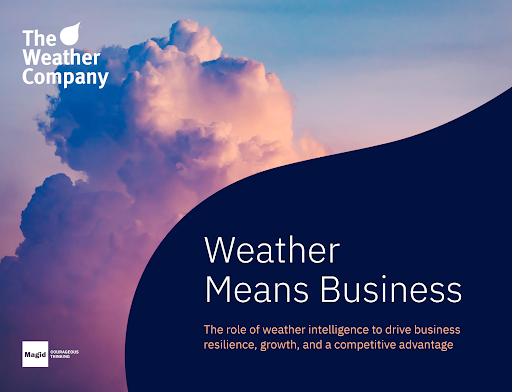

Download our free and exclusive Weather Means Business report to learn how smart businesses are transforming their enterprise strategies with innovative weather intelligence.
Get your copyFuture-proof your business with The Weather Company
As businesses look to the future, integrating weather intelligence into long-term planning is a must. At The Weather Company, we offer unparalleled forecasting capabilities and weather intelligence that enable businesses to thrive in the face of changing weather patterns. With over 40 years of expertise in weather data science, we’ve become the world’s most accurate forecaster4, a distinction that sets us apart from other providers. Our commitment to innovation and accuracy has earned us the trust of consumers and businesses around the globe.5
Beyond accurate forecasts, we provide scalable, proven solutions for consumers and businesses alike. Businesses tapping into these weather insights will be better positioned to anticipate consumer needs and tailor their offerings.
- Weather Engine™ is a proprietary AI/ML insights platform and API that provides the precision and scalability your business process optimization needs to stay ahead.
- Weather Targeting enables advertisers to deliver personalized and relevant messaging that resonates with their audience in real time, across the digital ecosystem.
- Premium consumer experiences across The Weather Channel digital properties help marketers engage with consumers at scale in meaningful moments to help them live healthier, safer, smarter, and happier.
A robust weather strategy isn’t just a nice-to-have; it’s essential. Let’s work together to create a weather strategy that drives your business forward.
1 360M monthly active users based on the average of the total monthly (non-unique) users for Jan – June, 2023 across The Weather Company digital properties and consumer products (weather.com, The Weather Channel app, Weather Underground app, wunderground.com, Storm iOS app,) according to internal data
2 Weather Means Business report, October 2024, Magid for The Weather Company
3 Adobe Digital Economy Index 2023
4 ForecastWatch, Global and Regional Weather Forecast Accuracy Overview, 2017-2022, commissioned by The Weather Company
5 According to a Morning Consult Q1 2024 survey, The Weather Channel brand was the #13 most trusted brand in the U.S. The surveys were conducted from January 1, 2024 through March 31, 2024, among nationally representative samples of between 1,158 and 35,280 U.S. adults.







